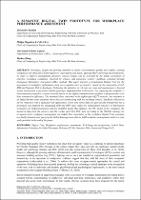Chapter A Semantic Digital Twin Prototype for Workplace Performance Assessment
| dc.contributor.author | Cleve, Felix | |
| dc.contributor.author | Bruttini, Alessandro | |
| dc.contributor.author | Hagedorn, Philipp | |
| dc.contributor.author | Getuli, Vito | |
| dc.contributor.author | Capone, Pietro | |
| dc.contributor.author | König, Markus | |
| dc.date.accessioned | 2024-04-02T15:47:20Z | |
| dc.date.available | 2024-04-02T15:47:20Z | |
| dc.date.issued | 2023 | |
| dc.identifier | ONIX_20240402_9791221502893_95 | |
| dc.identifier.issn | 2704-5846 | |
| dc.identifier.uri | https://library.oapen.org/handle/20.500.12657/89126 | |
| dc.description.abstract | Nowadays, despite the growing attention to indoor environmental quality and comfort, existing workplaces still often fail to meet employees’ expectations and needs, affecting their well-being and productivity. In order to improve management decisions, crucial insights can be provided by the timely correlation of objective workplace conditions, observed by sensors, and subjective workers’ feedback, collected through Ecological Momentary Assessment (EMA) method. This paper presents a prototypical Digital Twin for the assessment of workplace performance from an occupant-centric perspective, based on the integration of IoT, BIM and Semantic Web technologies. Following the definition of relevant use cases and requirements a layered system architecture is presented and the prototype implementation is discussed. For capturing the workplace’s environmental properties, a sensor network based on the Zigbee communication standard is proposed due to its data transmission efficiency. The measured data, converted in the lightweight MQTT protocol, are streamed to an InfluxDB time series database where they are stored along with the incoming workers’ feedback collected as survey responses with a dedicated web application. These time series data are queried and transported into a developed web platform for integrating BIM and RDF data within the standardized structure of Information Containers for linked Document Delivery (ICDDs). Inside this platform, the IFC model of the workplace, the measured data from the sensors, and the worker generated RDF data according to the WOMO ontology for occupant-centric workplace management are linked. The capabilities of the workplace Digital Twin prototype are finally demonstrated querying the linked heterogeneous data to fulfil workplace management tasks in a case study provided at the end of the paper | |
| dc.language | English | |
| dc.relation.ispartofseries | Proceedings e report | |
| dc.subject.classification | thema EDItEUR::U Computing and Information Technology | |
| dc.subject.other | Digital Twin | |
| dc.subject.other | Workplace performance assessment | |
| dc.subject.other | Well-being and productivity | |
| dc.subject.other | Linked Data | |
| dc.subject.other | Information Container for linked Document Delivery (ICDD) | |
| dc.subject.other | Semantic Web | |
| dc.subject.other | Internet-of-Things (IoT). | |
| dc.title | Chapter A Semantic Digital Twin Prototype for Workplace Performance Assessment | |
| dc.type | chapter | |
| oapen.identifier.doi | 10.36253/979-12-215-0289-3.118 | |
| oapen.relation.isPublishedBy | bf65d21a-78e5-4ba2-983a-dbfa90962870 | |
| oapen.relation.isbn | 9791221502893 | |
| oapen.series.number | 137 | |
| oapen.pages | 13 | |
| oapen.place.publication | Florence |

